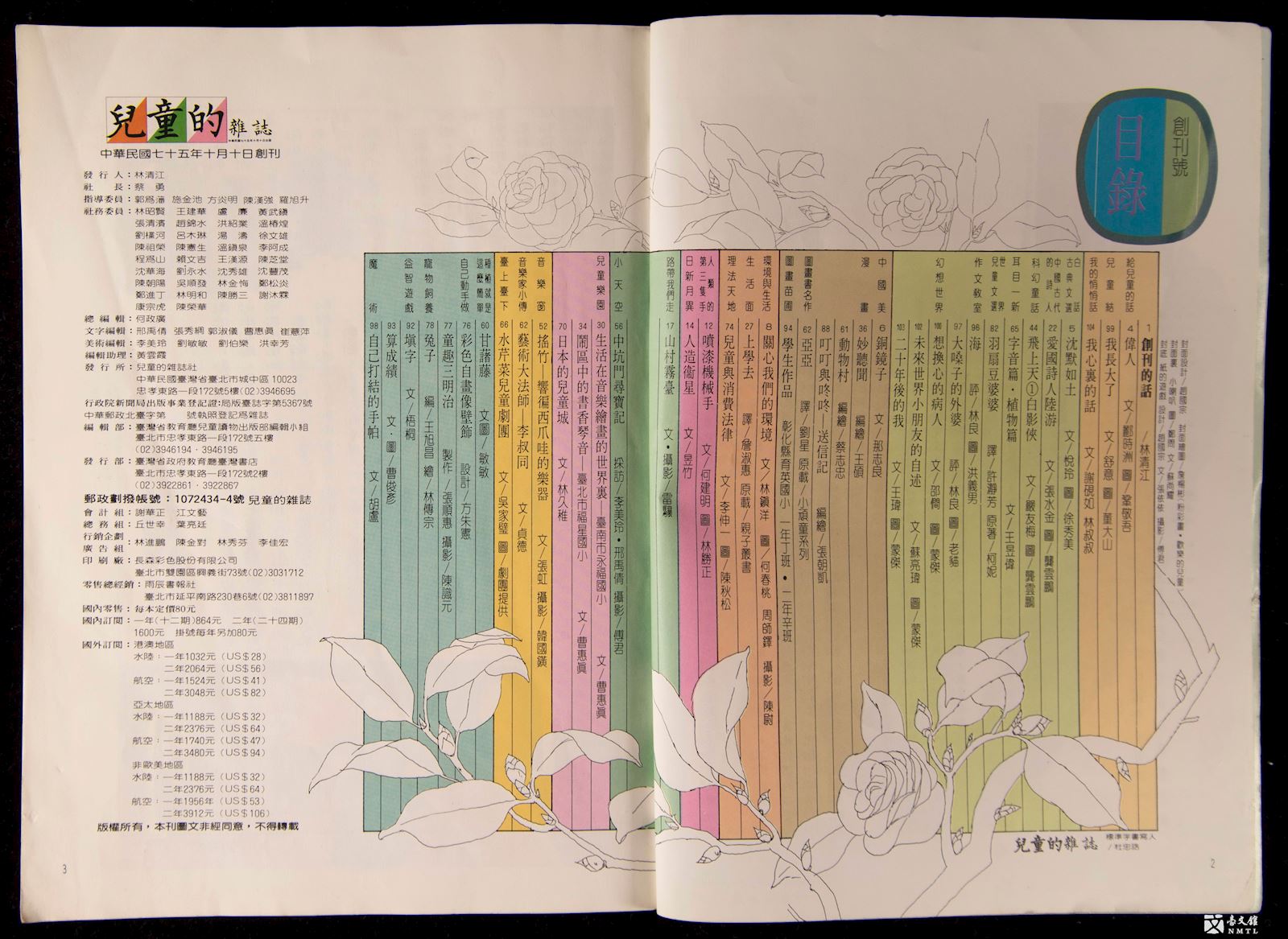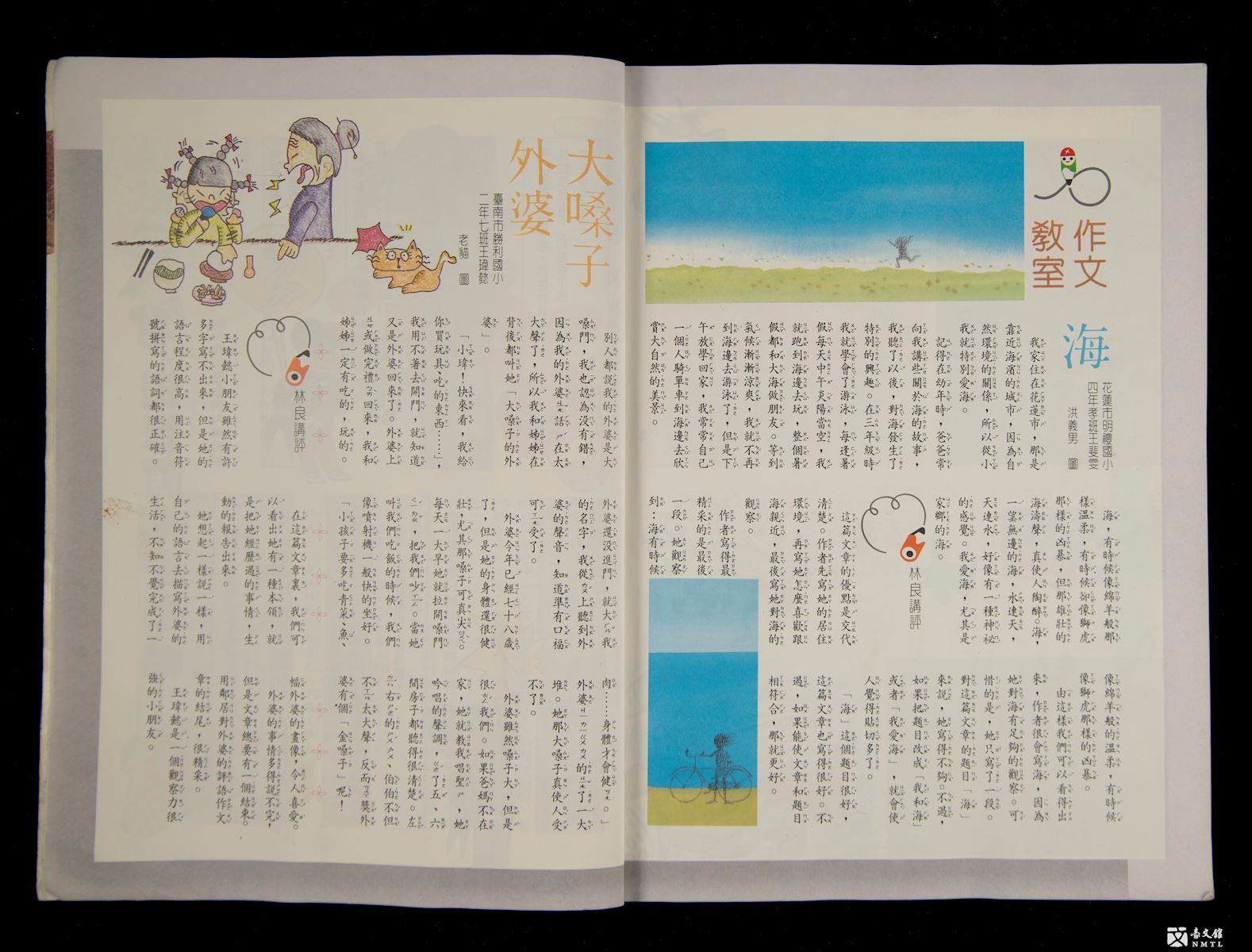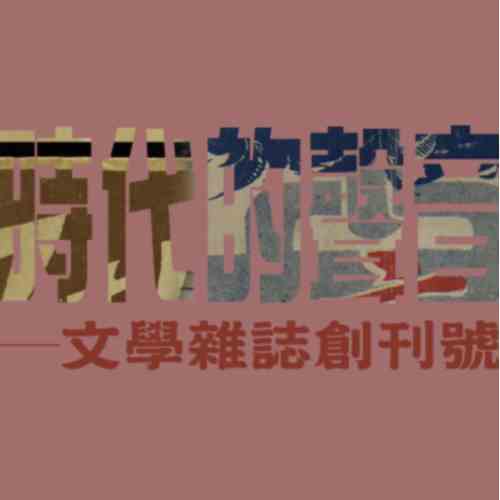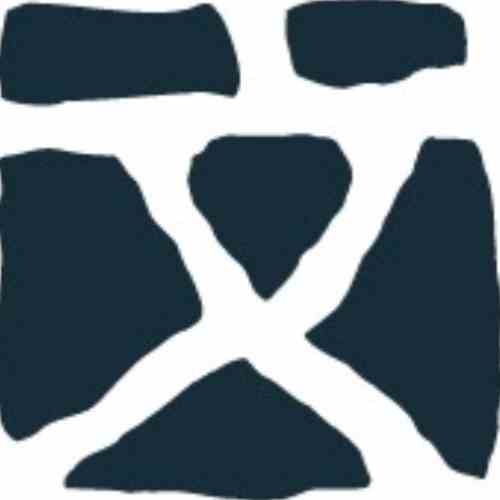Literary journals|Classical poetry journals|Modern poetry journals |Regional culture|Political journals|Children's journals
The Nationalist government of the Republic of China implemented martial law in Taiwan on May 20th, 1949, which restricted the people’s freedom. During the period of the ban on newspaper publications under martial law, the freedom of speech of newspaper supplements was regulated more strictly than that of the literary journals. In other words, the journals’ circulation was less than that of the newspapers, but the space for free creation was relatively greater. Roughly speaking, there were three types of literary journals during this period: the official, college, and popular literary journals. The authorities invested in the official literary journals to promote national literary and art policies, such as Literary Creation. The college literary journals involved literary personages with academic backgrounds, which depended on self-financing. The contents of these journals were mainly based on theories and creative works of belles-lettres. The popular literary journals referred to the publications for entertainment purposes. The “outside the party” journals played a significant role in information transmission and the loosening up of the freedom of speech.
Literary journals
.jpg)
▸ The inaugural issue of Taiwan Studies (Donated by Qin Xian-Ci)
Taiwan Studies, You Mi-Jian (publisher), Chen Qi-Lu (editor-in-chief), Taipei: Taiwan Culture Association. Commenced publication on June 30, 1956.
Although Taiwan Culture was published through Volume 5 in July 1949, shifting sociopolitical circumstances forced the journal to become a purely academic publication, which entailed the loss of intellectual perspectives critical of certain political activities as well as the exclusion of new ideas and literary theories. With the suspension of Taiwan Culture, the Taiwan Culture Association nearly ceased its activities but did not disband. In 1956, the organization was re-registered as the Taiwan Provincial Culture Association and soon began publishing Taiwan Studies as an annual journal. After several years of activity, however, the journal’s publication ceased.
.jpg)
.jpg)
◆ ◆ ◆
_NMTL20070461627(1).jpg)
▸ The inaugural issue of Literature Journal (Donated by Zhang Mo)
Literature Journal, Liu Shou-Yi (publisher), Xia Ji-An (editor-in-chief), began publication in September 1956 and ceased publication in September 1960. In total, 8 volumes were published, containing 6 issues in each volume. Literature Journal was founded under the anti-Communism atmosphere of the 1950s while Xia Ji-An, Wu Lu-Qin, Lin Yi-Liang and others attempted to seek more free space for literature. They revealed their objectives in the foreword to the inaugural issue of Literature Journal, “we expect that our readers could recognize this issue as a ‘literary journal.’ This journal was founded by a group who has been keen on literature. We do not tend to be unconventional in literary circles. We just want to keep our feet on the ground and keep writing diligently.” The editorial team quietly expected that the readers could identify this journal as a literary publication. It is not difficult to find the overtones that corresponded to the political and social environment of the time. In the contents, Literature Journal held a key position for the development of modernism in Taiwan. Not only was it sponsored by the United States Information Service, but also American modernism could be found everywhere among its contents. Furthermore, with the efforts of the writers and editors based on the ideology of liberalism, this journal became the critical piece for the development of modernism discourses and the creation of Taiwanese literature.
.jpg)
.jpg)
.jpg)
◆ ◆ ◆
封面_cca100013-li-s_00024_0001-0001-u(1).jpg)
▸ The inaugural issue of Wen Xin (Donatedby Lin Jin-Peng’s family)
Edited by Wen Xin Editorial Committee, Ye Ming-Xun as publisher, Xiao Meng-Neng as President. The inaugural issue of the Wen Xin (Issue 1, Volume I) was published with 38 pages on November 5, 1957. It was a cultural journal founded by Xiao Meng-Neng, who was also the founder of Wen Xin Bookstore. The initial purpose of the publication was to be a “lifestyle, literary and artistic” journal, focusing on literature and art. In November 1959, the editorial policy was changed to be a journal of “thought, life, and art” due to the reason that “people are guided by knowledge.” From 1957 to 1961, the literary column was edited by He Fan and later changed to Li Ao, meaning the journal entered the third stage of the publication. The most important occurrence was when the Wen Xin colleagues and the leader, Li Ao, began a controversy between Chinese and the western cultures with Confucius and Mencius Monthly published by the Mencius Institute in February 1962. From the 58th issue, in addition to the theme of the enlightenment, the journal added the reviews of the status quo of the society. At the end of 1965, due to Li Ao’s writing of “The Strict Statement of the Ban on Party,” Wen Xin was suspended with a total of 98 issues.
The style of Wen Xin was based on the promotion of new literature and the inheritance of new ideas. The contents covered literary criticism, modern poetry, fictions, biography, travel journeys, introductions of customs, science and technology reports, artistic and cultural activities. It included reports related to art fields, such as photography, woodcuts, and music. Wen Xin was named after the legend of “Wen (Chang) Star (Wen Xin),” which was the star that managed cultural issues. And the Greek mythology, Apollo, was also in charge of poetry and music. This journal adopted the implication of the myths of the east and the west to declare their etermination to fulfill their responsibilities for literature and arts.
.jpg)
.jpg.jpg)
◆ ◆ ◆
封面_NMTL20070461583(1).jpg)
▸ The inaugural issue of The Innovative Journal of Pen Assembly Monthly (Donated by Zhang Mo)
The Innovative Journal of Pen Assembly Monthly, Ren Zhuo-Xuan (publisher), Yu Tien-Cong, Xu Guo-Heng (editor-in-chief), began publication in 1959 and ceased publication in November 1961.
Tracing the history of the Innovative Journal of Pen Assembly Monthly, the first editor-in-chief was Wang Ji-Cong when the journal began publication in May 1957. This journal was led by the Chinese Writers’ and Artists’ Association (CWAA). It was initially published in the form of newssheet for about forty issues, discussing mainly the cultural issues of the time. Later, it stopped publication due to internal conflict until Yu Tien-Cong took over on May 4, 1959. Yu changed the journal style from newssheet to monthly, as well as the size of the journal to approximately 148 x 105 mm. The cover of the inaugural issue presented Raoul Dufy’s work, Man Playing Contrabass. Most of the layouts presented the artwork of European contemporary artists selected by Liu Kuo-Sung. The journal contained introductions to western literary theories and criticisms, as well as to writers’ works, which provided pioneering contributions in Taiwanese literature circles of the time.
.jpg)
.jpg)
◆ ◆ ◆
.jpg)
▸ The inaugural issue of Literary Trends (Donated by Yin Xue-Man)
The inaugural issue of Literary Trends, Yin Xue-Man (publisher), Peng Pin-Guang (editor in chief), published on April 10th, 1978, 303 pages.
Literary Trends was a quarterly of literary discourses, reports, and creative works that was edited by the Ching-Shi New Literary Arts Academy in the Republic of China. It started publication in 1977, right after the Taiwan Nativist Literature Controversy. It aimed “to investigate and analyze the contemporary literary trends on a worldwide scale from the tradition of Chinese literary trends.” It also aimed to establish “a new philosophical system which can integrate the new and old, and then raise the human nature to a better level,” and moreover, “this new philosophical system would definitely belong to both China and the Chinese people and also follow the tendency towards the contemporary zeitgeist, communality and cosmopolitan.” (Yin Xue-Man, “Forward to Literary Trends”)
.jpg)
.jpg)
.jpg)
.jpg)
◆ ◆ ◆
.jpg)
▸ The inaugural issue of The Litterateur (Donated by Zhang Mo)
The Litterateur, Xie Yu-Bin (publisher), Lin Wen-Yi (editor-in-charge), Liu Yi-Ping (editor-in-chief), began publication in October 1985 and ceased publication in May 1986. In total, 7 issues were published.
The Litterateur was a journal that revealed the writers’ lives. It was published by Xue Ying Cultural Co., whose person in charge was Qiu Qing-Zhang and editorial consultant was Huang Wu-Zhong. There were a few set columns to provide readers with opportunities to participate in information exchanges, such as “writer information” and “literature questionnaire.” The entire journal was divided into several columns. Columns called “the images of litterateurs” and “literary homeland” showed the environment of the writers’ growth and writing styles. A writer was selected in each issue to be the focused figure. Columns called “Wenyuan Qinghua” and “scabbard” reviewed literary works, phenomena and the concepts of literary theories.
.jpg)
.jpg)
◆ ◆ ◆
.jpg)
▸ The inaugural issue of Literary Creation (Donated by Qin Yun-Sheng)
The inaugural issue of Literary Creation, Zhang Dao-Fan (publisher), Ge Xian-Ning (editor in chief), publication started in May of 1951 and was suspended in December of 1956.
Literary Creation, the official journal of the Chinese Literature Awards Committee, published a number of the winning works of the Chinese Literature Award and provided a relatively huge bonus to the prizewinners in the 1950s. The editors-in-chief of the 68 issues in total were, in chronological order, Ge Xian-Ning, Hu Yi-Guan, Wang Ping-Ling, and Yu Jun-Zhi. Although the journal’s style differed with the change of the editor-in-chief, it mostly responded to the policies of the time, such as “free China,” “the anti-communism literature,” and later “the literature of combat policy.” The size of the journal ranged from 130 mm x 190 mm to 190 mm x 260 mm approximately, but its price was kept consistent.
.jpg)
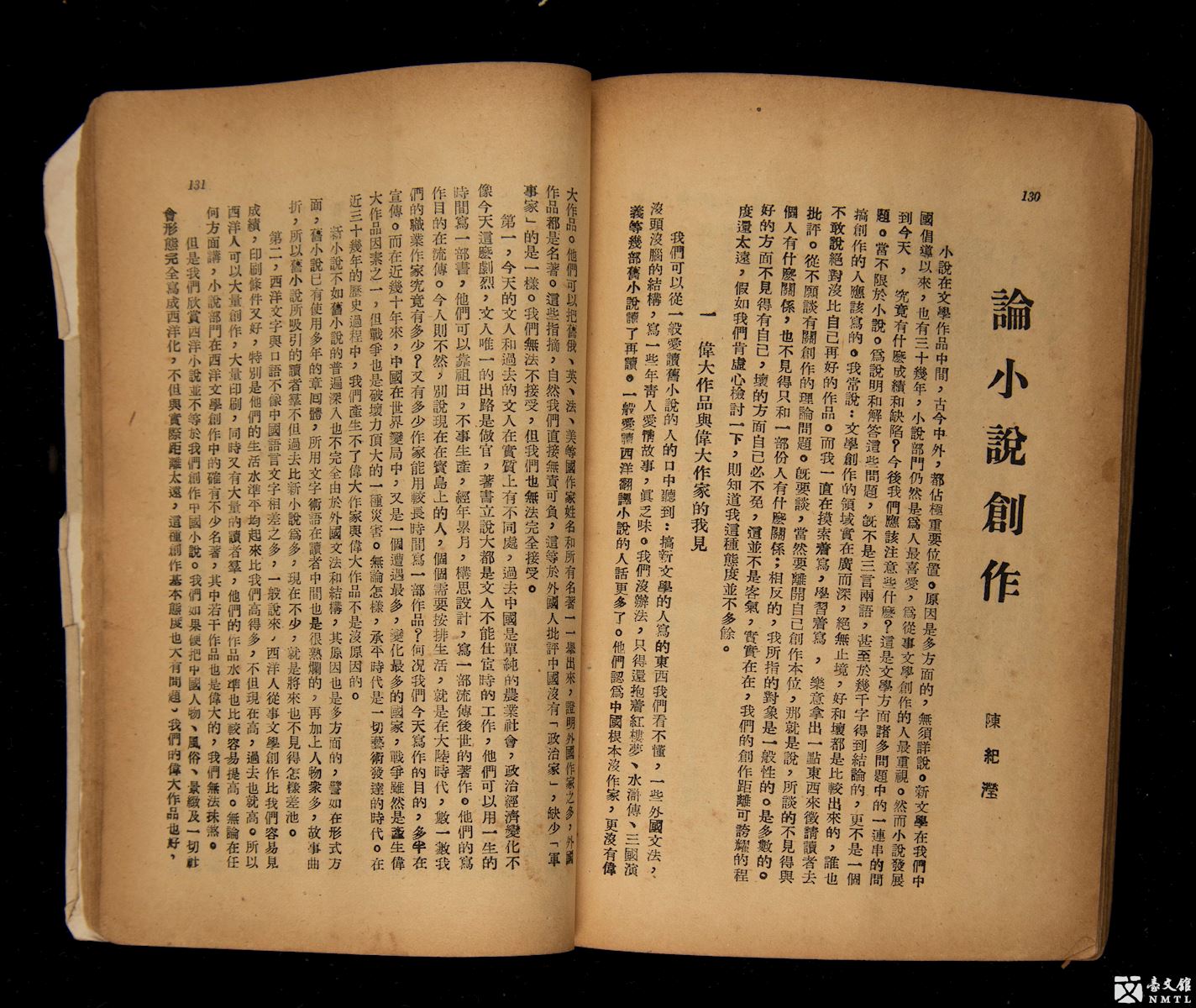
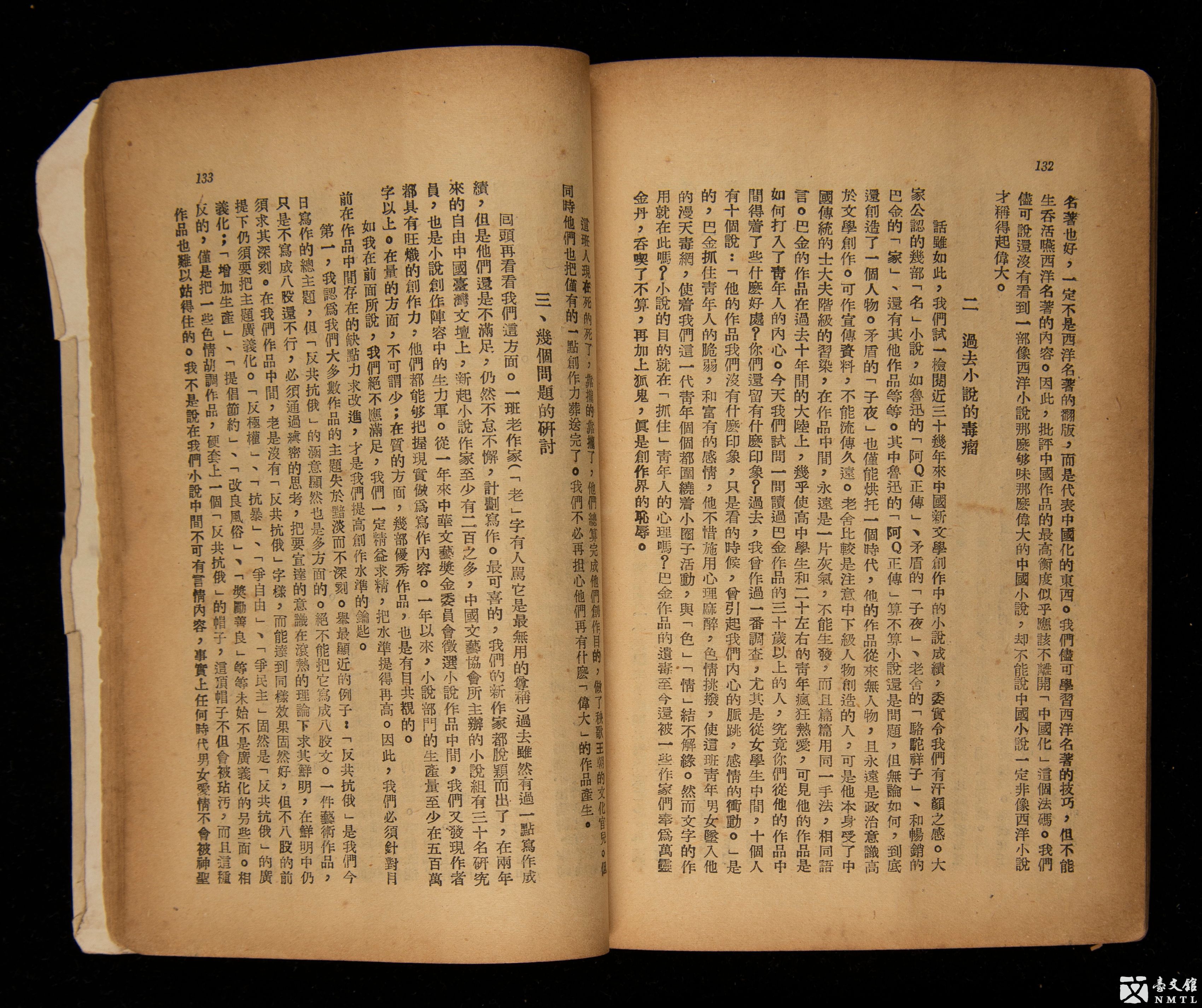
.jpg)
◆ ◆ ◆
.jpg)
▸ The inaugural issue of Wenhsun (Donated by Lin Jin-Peng’s family)
Wenhsun founded on July 1, 1983, by Wenhsun Magazine Press, in a total of 118 pages, with Sun Qi-Ming as the editor-in-chief. The journal is still being published.
The founding of Wenhsun could be traced back to the “National Third Literary Talk” held in 1981. Many people in the arts and cultural circles advised the government to establish a center for literary and art materials. As a result, Zhou Ying-Long, the convener, founded the The Research and Service Center for Arts and Literature Materials in the following year, and he planed to organize a journal. By July 1983, Wenhsun was successfully published. Its purpose was to serve the literary and art circles and the public. In addition to the collection, collation and research of literary and historical materials, it also expects itself to establish a model for domestic literary criticism, and systematically provided complete art and literary information, such as authors’ works and activities.
The inaugural issue used senior writers Su Xue-Lin and Wang Shi-Lang as cover people, who were the respondents of the “Interview with Wenhsun” column. The main column “Thematic Talk by Pen" was based on the topic of “How to establish a rigorous literary criticism.” In addition, there were many units, such as “Literature Window,”"Writer's Review," “Discussion on Arts and Literature, “Book Review,” “Book Forest,” “Introduction to LiterarySocieties,” “Information of Literary Court.” The first editor-in-chief of the journal was Sun Qi-Ming. From the 15th issue, Li Rui-Teng took over, and Feng De-Ping served as the deputy. From the 84th issue, Feng De-Ping was promoted to the editor-in-chief, and Li Rui-Teng served as the consultant. In January 2003, the government stopped providing a budget for Wenhsun. Feng De-Ping then and set up the Taiwan Literature Development Foundation to maintain the journal. After decades of development, Wenhsun has always presented the appearance of literary circles in Taiwan from professional and diverse perspectives and laid a solid foundation for Taiwanese literature. It is an indispensable reference for understanding and studying Taiwan literature.
.jpg)
.jpg)
Classical poetry journals
.jpg)
▸ The bound edition of Taiwanese Poetry Society Vol.1, No.1- Vol.2, No.6 (Donated by Zhou Ding-Shan’s family)
On the Poet’s Day in 1951, the Taiwan Poetry Society was founded under the plan of the Director of the Taiwan Provincial Literature Association, Ceng Jin-Ke, and Taiwanese Poetry Society monthly was published simultaneously. The honorary president was Yu You-Ren, with the president Jia Jing-De and vice-president Lin Xiong-Xiang. After the publication of the monthly, Taiwanese Poetry Society took over the arrangement of the annual poetry conference besides managing the publishing of Taiwanese Poetry Society.
.jpg)
◆ ◆ ◆
.jpg)
▸ The inaugural issue of The Friends of Poetry and Literature (Donated by Zhan Yuan-Xiong)
Founded in 1953 in Changhua, Taiwan, the publisher of The Friends of Poetry and Literature was Hong Bao-Ku, with the president Wang You-Fen and the editor-in-chief Lin Jing-Nan. It aimed to “reorganize cultural heritage and carry forward the national spirit.” The main works published in the journal were classical poetry to promote interchanges between poets. In addition, the journal also published classical proses. The journal once published a series of debates on poetic innovation, and it made great efforts on the continuation of Chinese poetry. Since the 1st issue of the 39th volume, it was renamed The Friends of Chinese Poetry and Literature. The Friends of Poetry and Literature ceased publication in 1993, and it was one of the publications with the longest active period and the most circulation during the postwar era.
.jpg)
.jpg)
◆ ◆ ◆
.jpg)
▸ The inaugural issue of Chinese Poetry Court (Donated by Zhan Yuan-Xiong)
Publication from February 26, 1955, until June 1960, Chinese Poetry Court was among the most significant journals of Chinese poetry in postwar Taiwan. Renamed Chinese Arts Court beginning with Volume 12, the journal was supervised by president Liang Han-Cao, vice-presidents Li Yu-Shu, Wang Guan-Yu, and Gui Hua-Yue, editor-in-chief Li Yu Shu, publisher and executive editor Zhang Zuo-Mei, and executive editor Zhuang You-Yue. Many authors who published work in Chinese Poetry Court were from abroad, and the journal even established a column, “New Voices from Overseas,” for intellectual exchanges among poets worldwide, including several Chinese poets from Singapore and Malaysia.
.jpg)
.jpg)
.jpg)
◆ ◆ ◆
.jpg)
▸ The inaugural issue of Kunnan Poetry Court (Donated by Zhou Ding-Shan’s family)
The inaugural issue of Kunnan Poetry Court started publication in 1956 by the poet Shen Da-Fu, and it ceased publication in 1961. In addition to the honorary president Kong De-Cheng, the core members were the president Ceng Jin-Ke, vice president Chen Jie-Xing (the mayor of Kaohsiung County of the time) and Ou Zi-Liang, and publisher Shen Da-Fu (Feng Ren). It was a journal from southern Taiwan, published by Kunnan Poetry Court Press. Besides the Kunnan Poetry Court, the press also issued Kunying Selected Poems, which aspired to promote the creative works of both local and mainlanders.
.jpg)
.jpg)
Modern poetry journals
.jpg)
▸ The inaugural issue of Today’s Poetry (Donated by Zhao Tian-Yi)
Edited by Today’s Poetry Society, published by the Today’s Culture Enterprise Company, Starting publication on January 1, 1957, 25 pages.
Today’s Poetry was founded in Taipei City for promoting modern poetry and uniting local and foreign poets. The poet Zuo Shu-Ping, who was graduated from the Whampoa Military Academy, served as the publisher and president, with Zhong Lei and Ji Xian as vice-presidents, Shang Guan-Yu as executive editor. The four people were associated with Tan Zi-Hau, Peng Bang-Zhen, Li Sha and Fang Si as the editorial committee. The purpose of the journal was to unite the members of Today’s Poetry, the poets who loved freedom and truth, and to present the works of modern Chinese poetry. Furthermore, the journal aimed to promote the creation and expanding the field of modern poetry, as well as the combat literature with anti-communist and anti-Russia themes. This journal, which strongly echoed the atmosphere and the direction of creation of the time, was ceased in November 1957, with a total of 11 issues.
.jpg)
.jpg)
◆ ◆ ◆
.jpg)
▸ The inaugural issue of Poetry Vessels Quarterly (Shi Mai Quarterly) (Donated by Yan Shang (Yan Zhen-Xing))
Poetry Vessels Quarterly (Shi Mai Quarterly), Yan Shang (editor-in-chief), Nantou: Poetry Vessels (Shi Mai) Poetry Society, began publication on July 25, 1976 and ceased publication on March 25, 1979. The signatures of Yan Shang were seen on the pages of the foreword to the inaugural issue of Poetry Vessels Quarterly with “The rhythm of the poetry” and “Editor’s notes.”
“The rhythm of the poetry” revealed three expectations of the poetry society: “to inherit the tradition of Chinese poetry,” “to discuss the cause and effect of poetry,” and “to take the pulse of poems with a sincere attitude.” “Editor’s notes” mentioned the reasons to establish a poetry society: “there have been a number of poetry societies and journals so far. However, most of them seemed to operate behind closed doors and writers had little or no access...therefore, we go our own way along with companions…sincerely we welcome more people to come with us.”
.jpg)
.jpg)
◆ ◆ ◆
.jpg)
▸ The inaugural issue of The Prairie (Donated by Zhang Xin-Ji)
Nan Yu (editor-in-chief), Prairie Poetry Society. Commenced publication on March 31, 1984, as a single, four-page newssheet.
The Prairie poetry journal was an internal publication of the Prairie Poetry Society, a literary society at Fu Jen Catholic University, published quarterly in March, June, September, and December every year to showcase the creative work of the society’s members. The first page of the inaugural issue reveals the names of the group’s nine members: Nan Yu, Yu Qing, Huang Xu-Chu, Ceng Shu-Mei, Xu Wang-Yun, Jie Lu, Lan Jian, Zhang Si, and Wang Wan-Xiang. Later, as the society continued to develop, its membership rose steadily. Although most members were students majoring in Chinese literature, others had backgrounds in science or engineering, and most creative work published in the journal consisted of classical lyrics. The society’s president and editor-in-chief, Ji Ye (Zhang Xin-Ji), reportedly stated that though members might be somewhat ignorant of ways to uphold the core value of the journal and society, the group’s mission of inspiring poetics was no different from that of general poets and writers. Eight issues of The Prairie were published, including on special topics such as the work of Nan Yu, Ceng Shu-Mei, and Ji Ye, until the journal ceased publication on December 15, 1985.
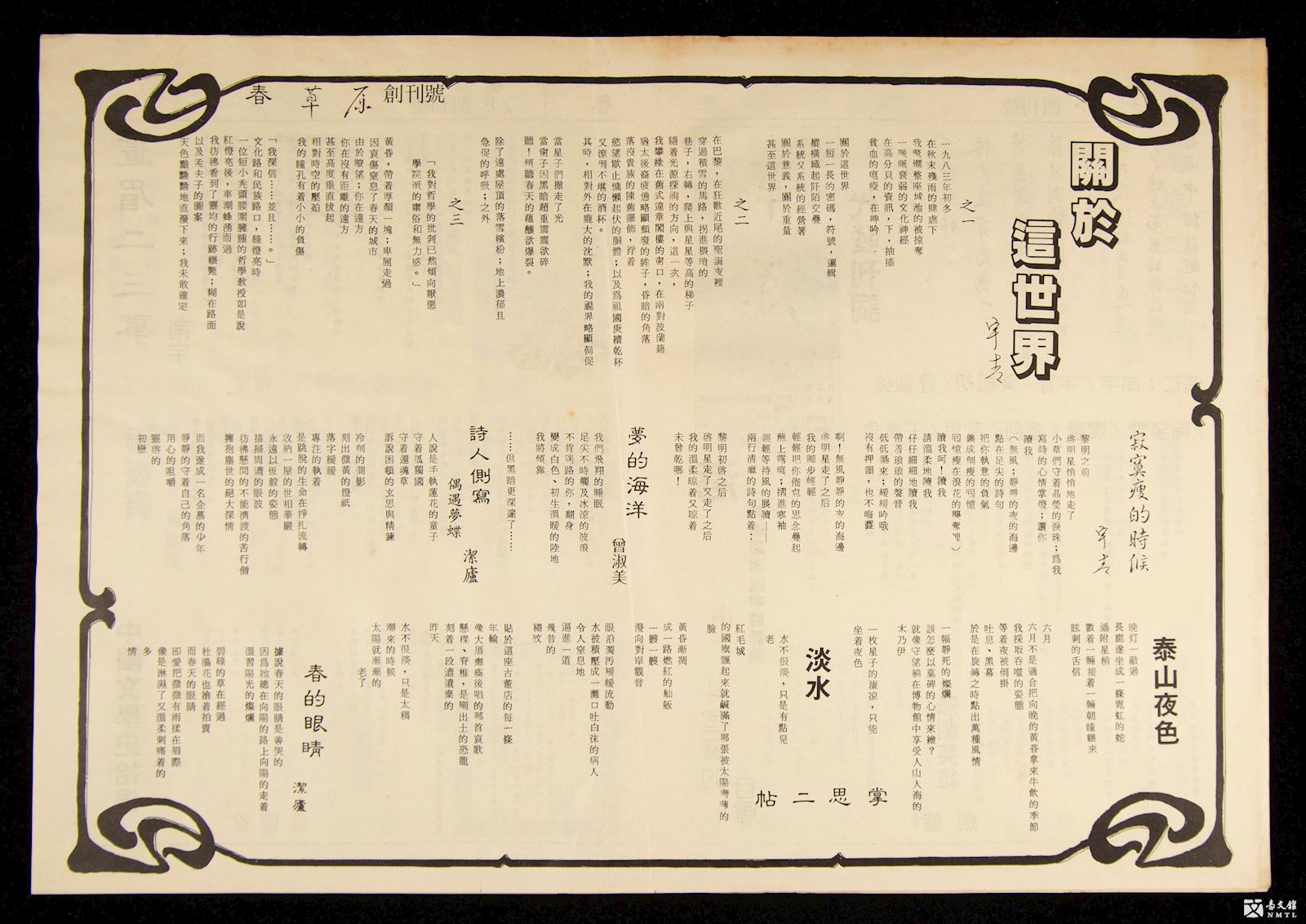
Regional culture
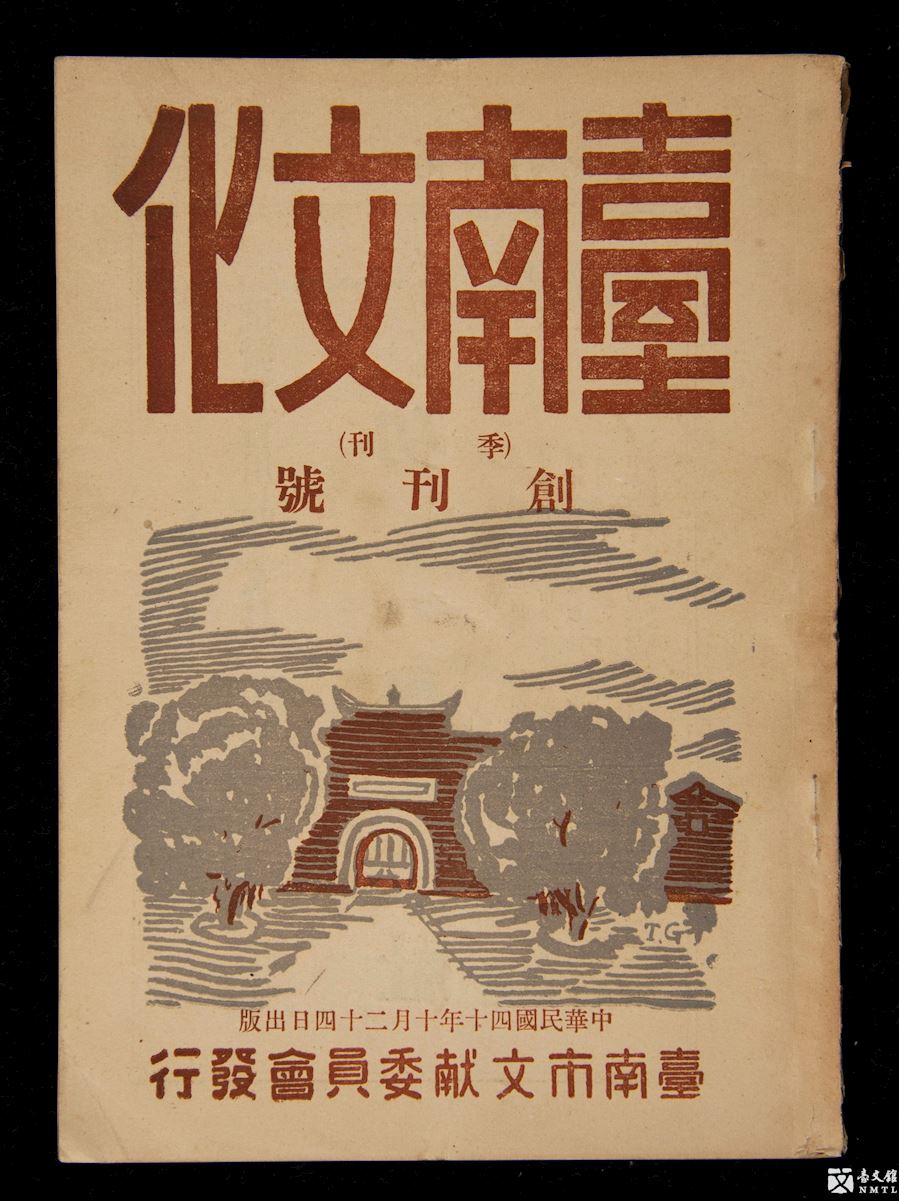
▸ The inaugural issue of Tainan Culture (Donated by Huang Zi-Qian)
The inaugural issue of Tainan Culture, edited by the Compilation Group of the Historical Research Commission of the Tainan City, published by the Historical Research Commission of the Tainan City on October 24, 1951, 63 pages.
Tainan Culture was the first publication of the Historical Research Commissions around Taiwan. It was issued by the Historical Research Commission of Tainan City on October 24, 1951, The journal collected and compiled the Tainan literature in the form of a quarterly publication to promote the development of the Tainan culture. It mainly publishes various cultural studies related to the history of Tainan City, such as various old records, maps, literature, songs, local anecdotes, historical heritage and biographies of celebrities. Regarding its naming, it focused on Tainan's unique cultural and the position as a historic capital, we well as for popularization. Therefore, Tainan Culture was chosen instead of the name of “documents” or “literature”, which were used by other cities. The form of naming Tainan Culture established its particularity. The cover of the inaugural issue was Koxinga Shrine, which was drawn by Yan Shui-Long. The journal contains many articles, such as “The investigation of the prehistoric relics of Tainan”, “The brief history of the development of Tainan City”, “Tainan and Zheng Cheng-Gong”, “The restoration of Chihkan Tower (Old Fort Provintia)”, “Lian Ya-Tang and his poems”, “A brief history of the streets in Tainan City”, and “The review and prospects of the education system in Tainan”.
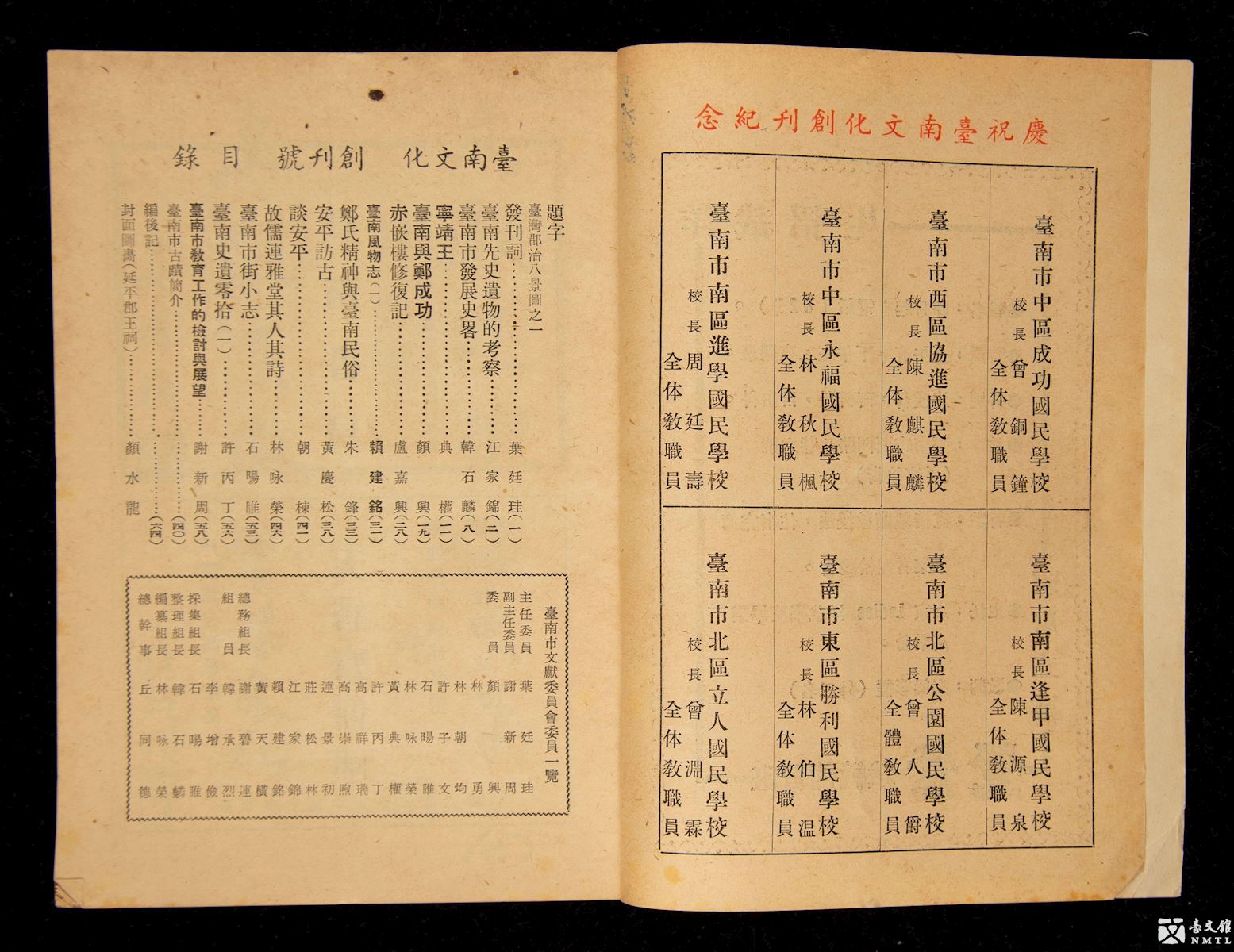
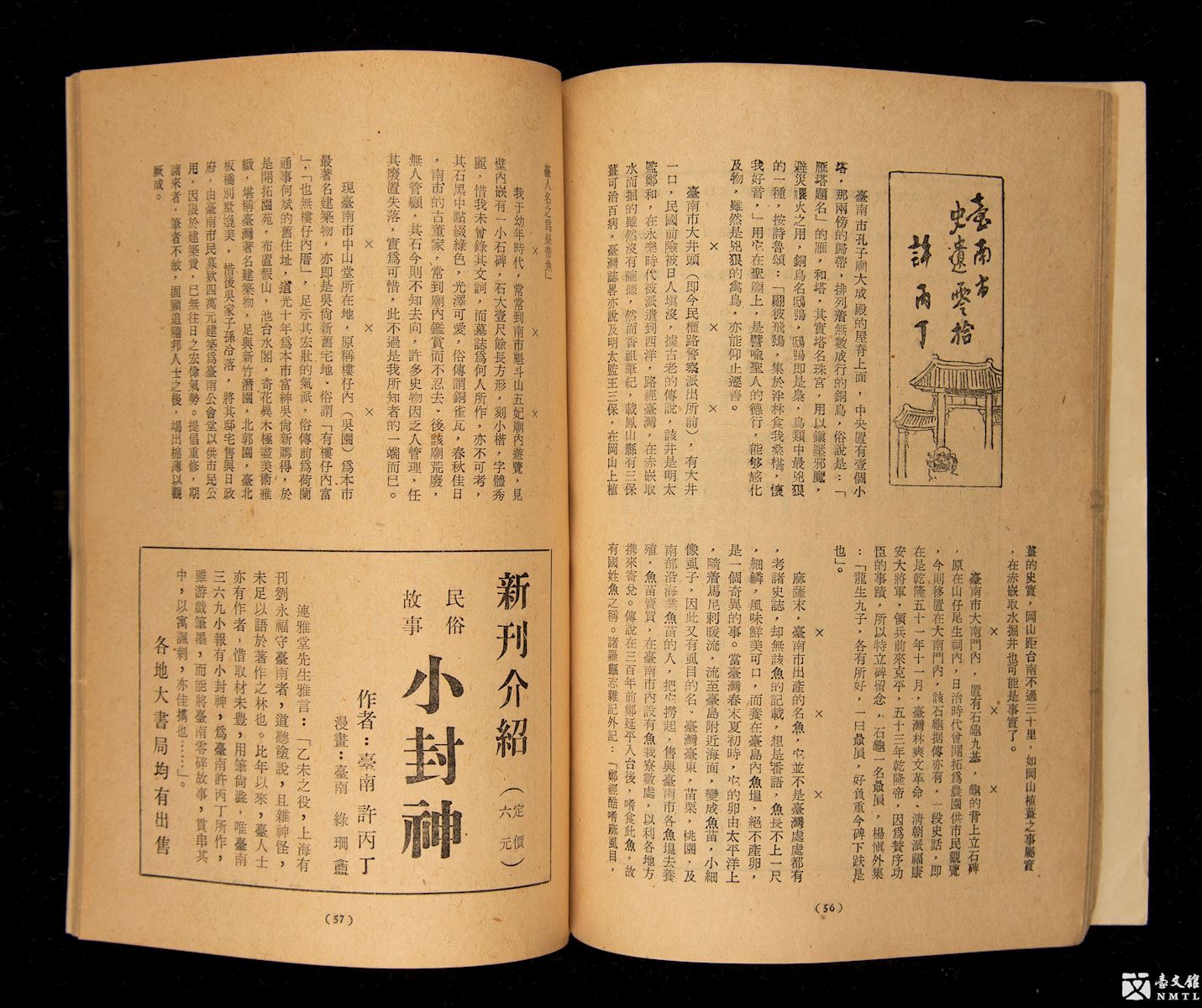
◆ ◆ ◆
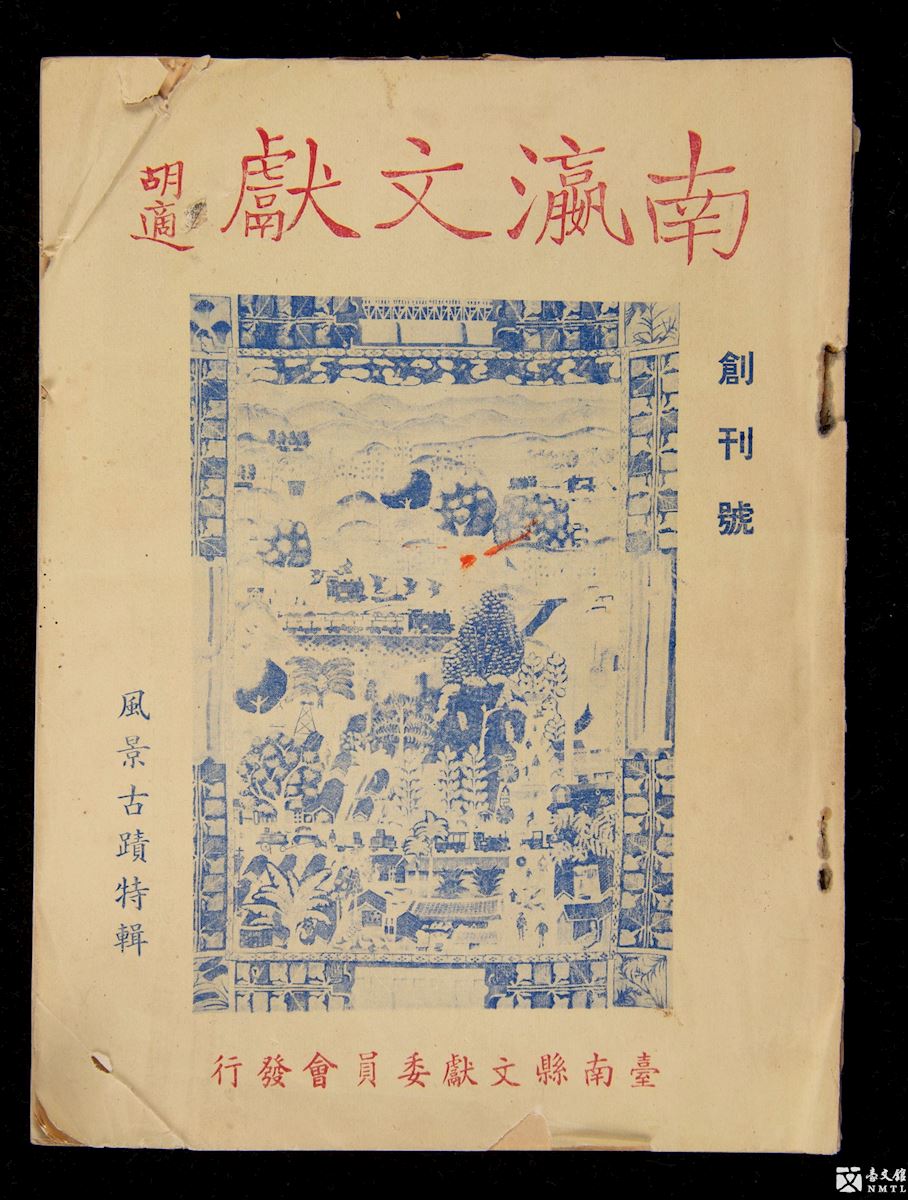
▸ The inaugural issue of Nanying Literature (Donated by Huang Zi-Qian)
Edited by the Compilation Group of the Historical Research Commission of the Tainan County, published by the Historical Research Commission, founded on March 15th, 1953. (Issue 1, Volume 1, 56 pages)
After the establishment of the Tainan County Government in 1946, Nanying Literature was founded in March 1953 in order to preserve the historical and cultural materials and construct a complete local history of Tainan County. At the beginning, it aimed at editing the local history, and later it became a field for literature and history worker to release their works, including the articles on the literary and historical research related to politics, economy, culture and history of Tainan County. In the early days, it was a quarterly, combining four issues into a volume. After 1959, it was published in the form of a bound volume of journal. After 1960, Wu Xin-Rong became the editor in chief of the journal. As of 1999, a total of 43 bound volumes were published. Since 2002, it was changed to an annual publication, but it was suspended in 2010. After the merge of Tainan County and City, it was merged with Tainan Culture. The title of Nanying Literature was written by Hu Shi. The cover of the inaugural issue was “the construction map of Chianan Irrigation System”, and the inner pages included the inscriptions of local literati, such as Huang Chun-Qing, Huang Chao-Qin, Wu San-Lian. The contents contained “The Tainan County chronicles”, “The first draft of the study in geographical names of Tainan County”, “A study in Kingdom of Tungning (Zheng Kingdom)”, and “Tainan County during the Yu Yong-He’s era”. The special topic of this issue was “special scenic spots”, introducing the famous scenic spots in Tainan County, such as Guanziling , Hu-Tou Pei, Coral Pool, Chianan Irrigation System. At the end of the publication, “Interview record”, written by the Collection and Compilation Groups of the Historical Research Commission of the Tainan County, left valuable references for future research in the Tainan district.
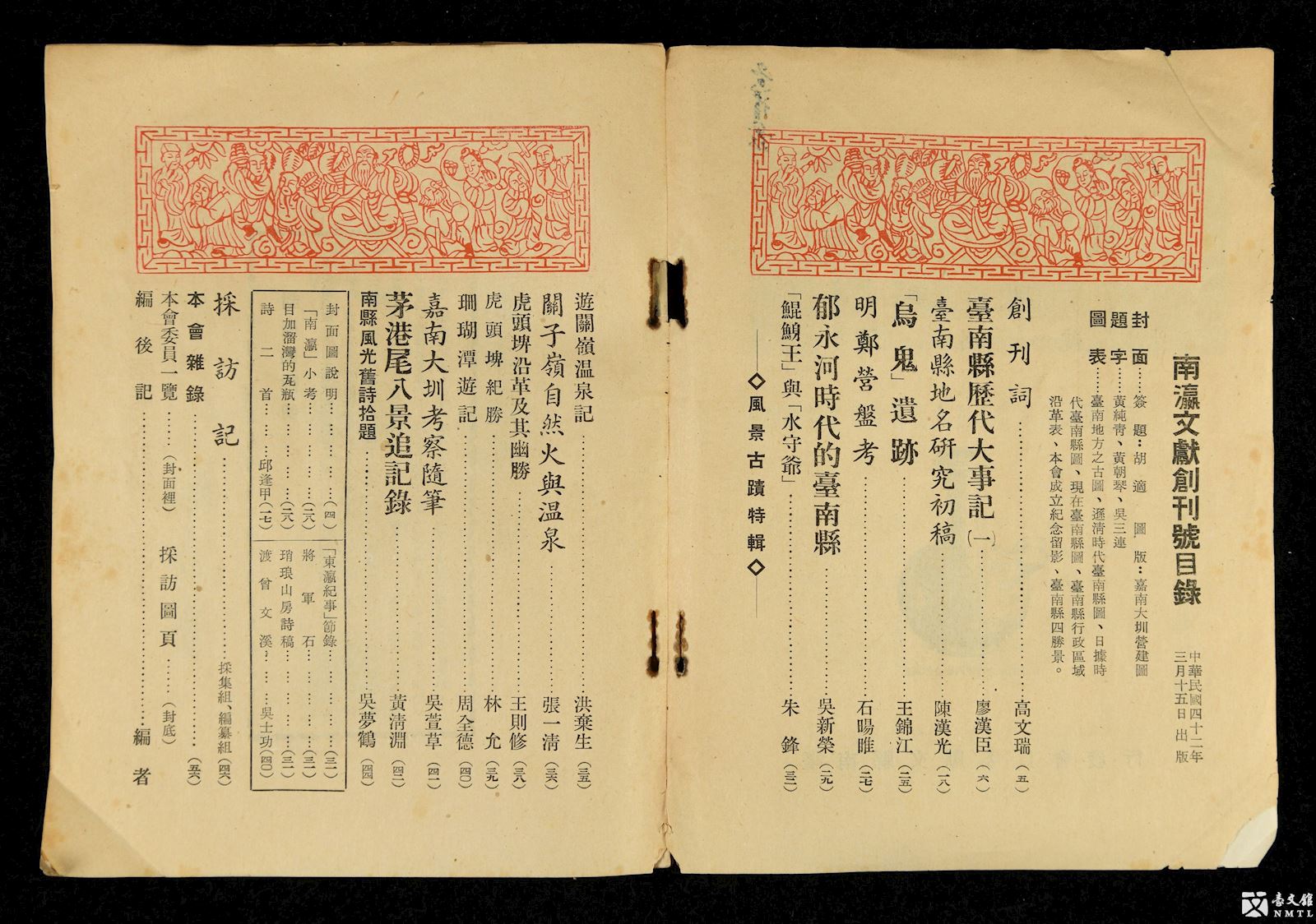
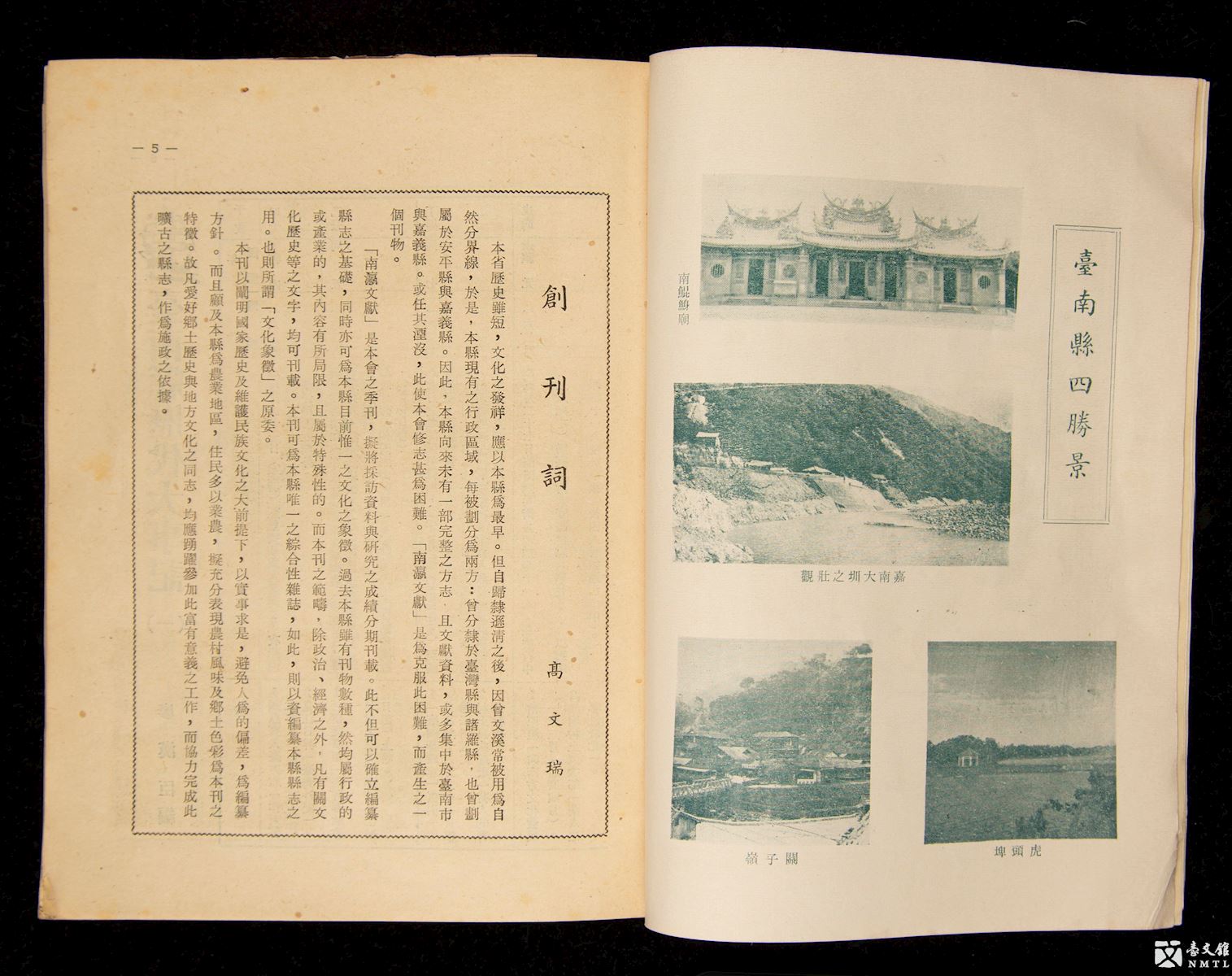
Political journals
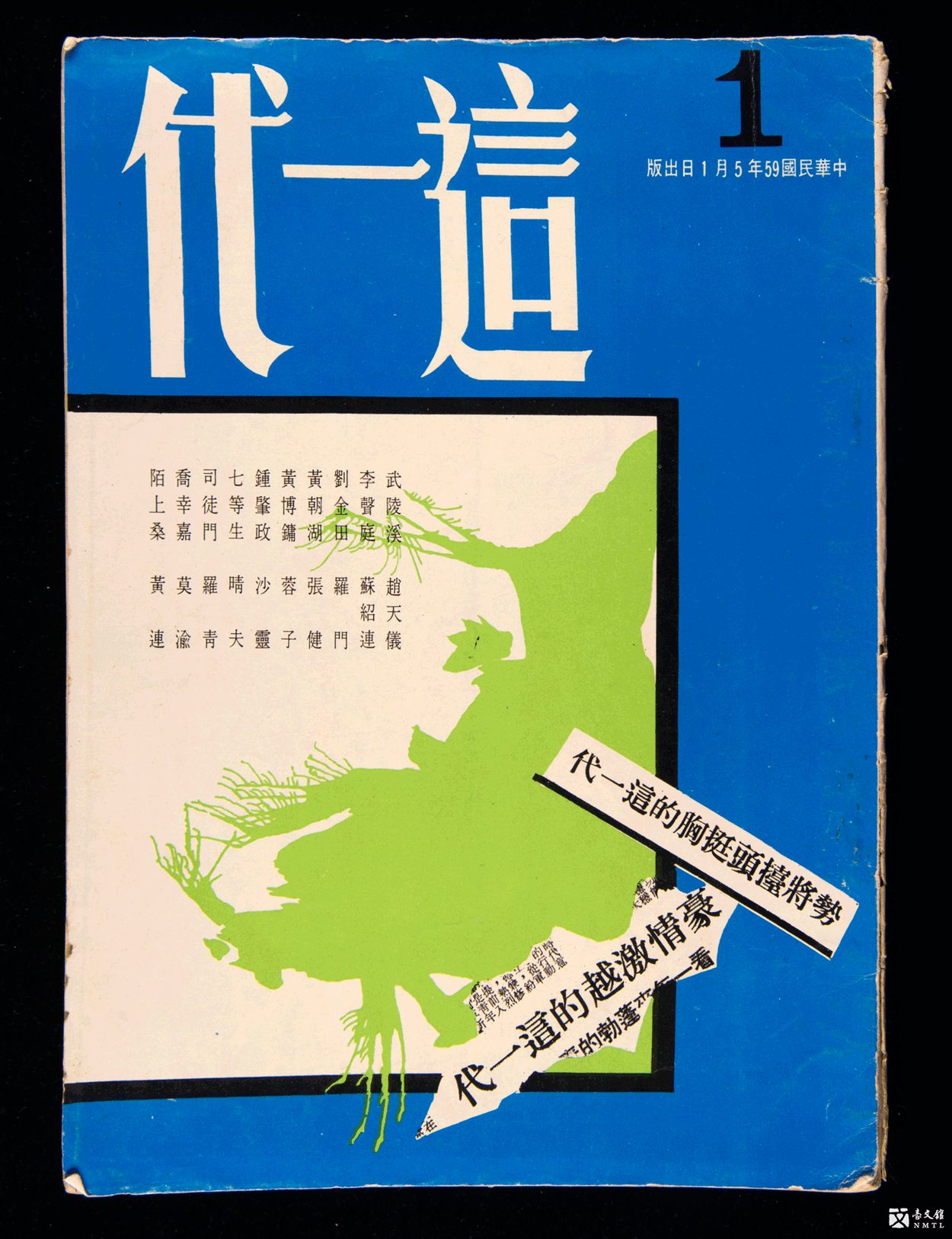
▸ The inaugural issue of This Generation (Donated by Zhang Mo)
This Generation, Hong Xing-Fu, Chen Heng-Jia, Mo Shang Sang (founders), Wu Zhong-Sen (publisher), began publication in Taichung in 1970 and ceased publication in October of the same year, with 6 issues published in total.
In the early 1970s, the establishment of journals was a medium for protesting against the authorities under the ban on political parties and newspaper publications. As a result, the “outside the party” journals rose in prominence. However, as the discussion became more heated due to the general elections, the suppression of speech was strengthened, which led to the seizures, ban or suspension of the “outside the party” journals. This Generation was founded by Hong Xing-Fu, Chen Heng-Jia and Mo Shang Sang, who all graduated from the Taiwan Provincial Junior Teachers College under this difficult political atmosphere. The journal focused on the rural areas in Taiwan and presented many social concerns, including how ordinary people faced the transformation of agriculture, industry and commerce.
◆ ◆ ◆
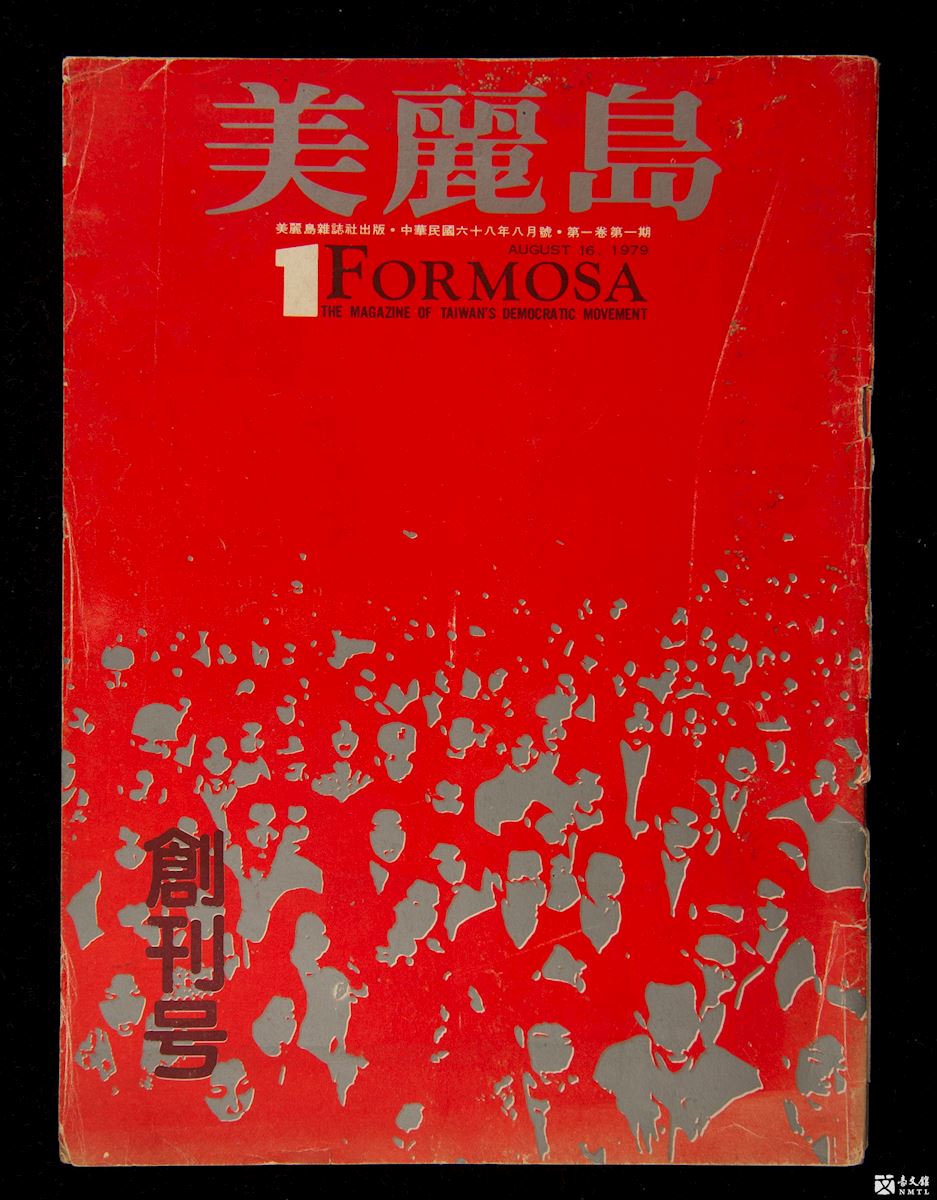
▸ The inaugural issue of Formosa Magazine (Donated by Wang Wei-Lian)
Formosa Magazine was first published in a 96-page issue in August 1979 with Chang Chun-Hung as editor-in-chief and ceased publication in December that year after the press was seized by the Taiwanese government.
In late 1977, Hsu Hsin-Liang and Shih Ming-Teh, while discussing the future direction of the group "outside the party", agreed that the group needed to be better organized and better manage its means of promotion. As a result, they decided to release a journal with the purposes of mobilizing and promoting the group that would consolidate forces to those ends and ultimately establish “a party without a name.” In April 1979, the organizers of Formosa Magazine, so named by Yao Chia-Wen’s wife Chou Ching-Yu, officially applied to the Information Office of the Taipei City Government for a publishing permit. Huang Hsin-Chieh served as publisher of the magazine, in collaboration with group president Hsu, vice-presidents Huang Tian-Fu and Annette Lu Hsiu-Lien, general manager Shih Ming-Teh, editor-in-chief Chang, and executive editor Chen Zhong-Xin (pen name: Hang Zhi). The journal’s editorial committee consisted of 61 elites from "outside the party", including Kang Ning-Hsiang, Huang Shun-Hsing, and Yang Kui.
Although the foreword to the inaugural issue, titled “To Promote the Political Movement of the New Generation Together” was attributed to publisher Huang, the actual author was executive editor Chen. That article revealed the purposes of the journal: “We have been inspired by people’s enthusiasm and willingness to participate in politics, and we firmly believe that democracy is the trend of the era and impossible to stop! Therefore, we founded this magazine to promote the political movement of the new generation!” The editorial of the inaugural issue, titled “Long Live Democracy,” outlined the issue’s various columns, including “Political Commentary from Outside the Party,” “Report from outside the party,” “Agricultural and Industrial Issues,” and “Formosa,” while the table of contents was accompanied by the mission statement “to develop the vitality of the new generation, to establish a reasonable society.” Sold for NTD 40, the issue became wildly popular; with more than 100,000 copies sold, it broke a circulation record and can thus be regarded as one of the most circulated political periodicals in history. Its popularity provoked the ire of the authorities, who responded by frequently suppressing activities related to the journal. Ultimately, escalating tensions between the sides prompted the Formosa Magazine incident (i.e., Kaohsiung incident).
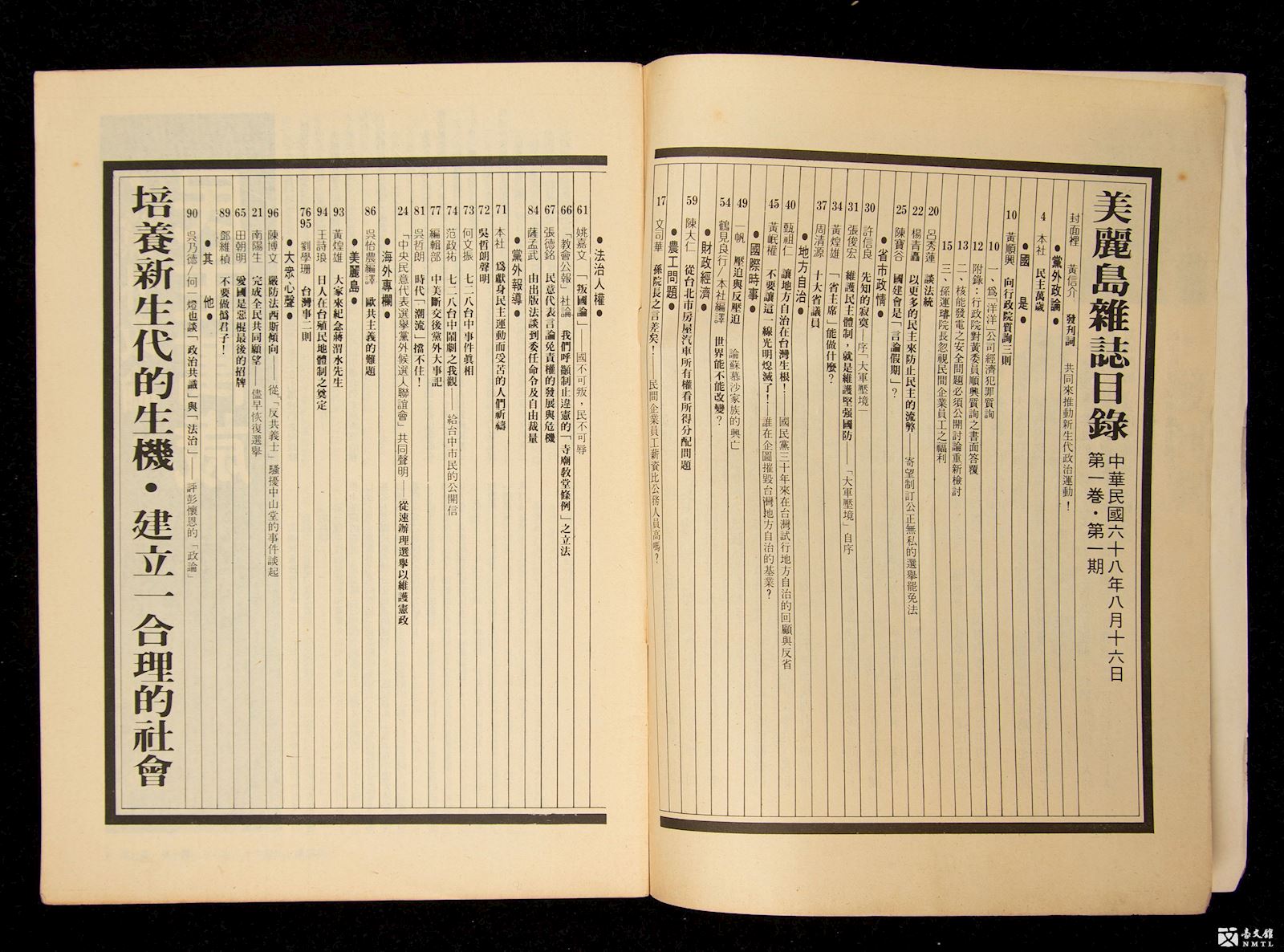
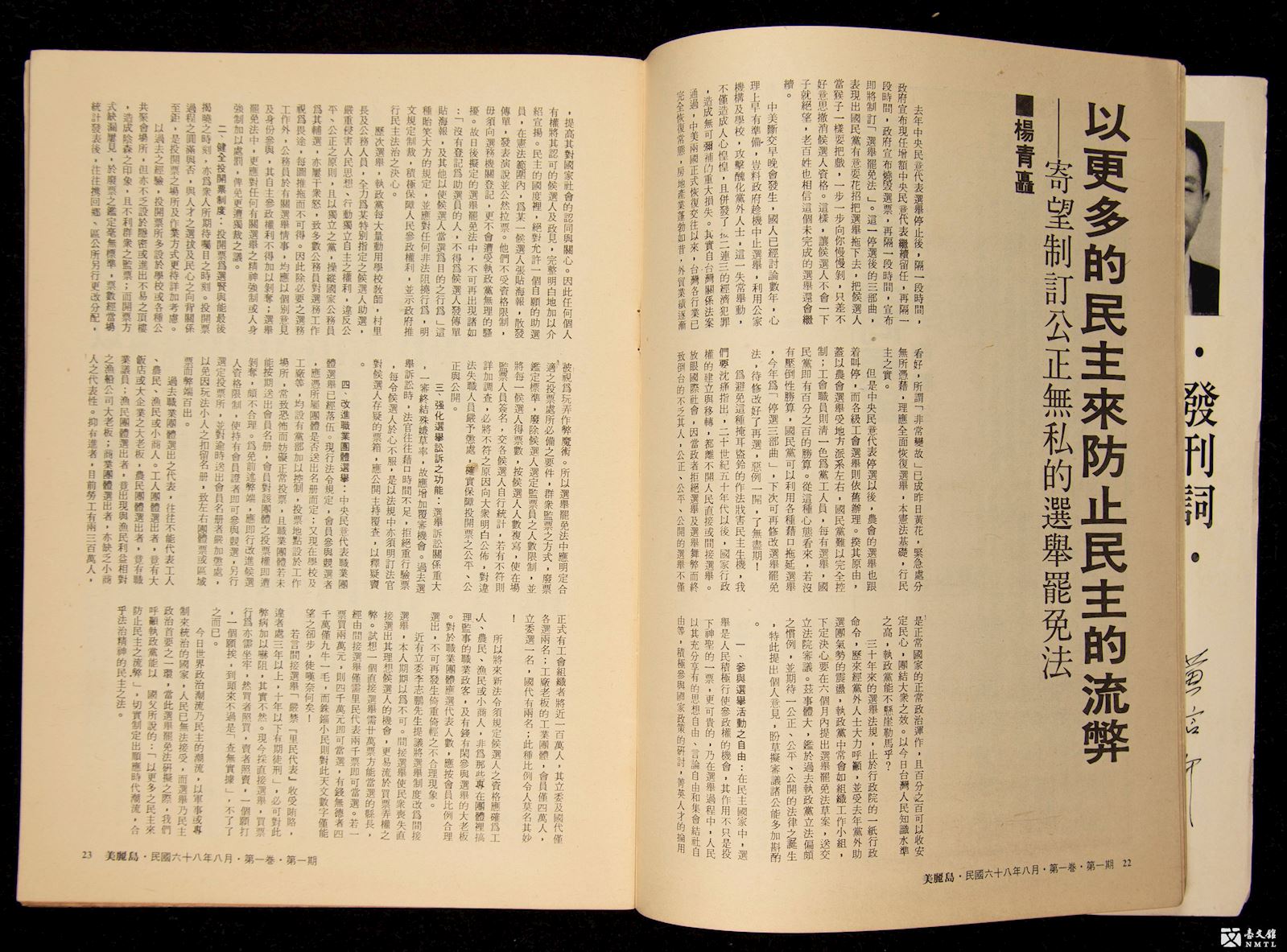
◆ ◆ ◆
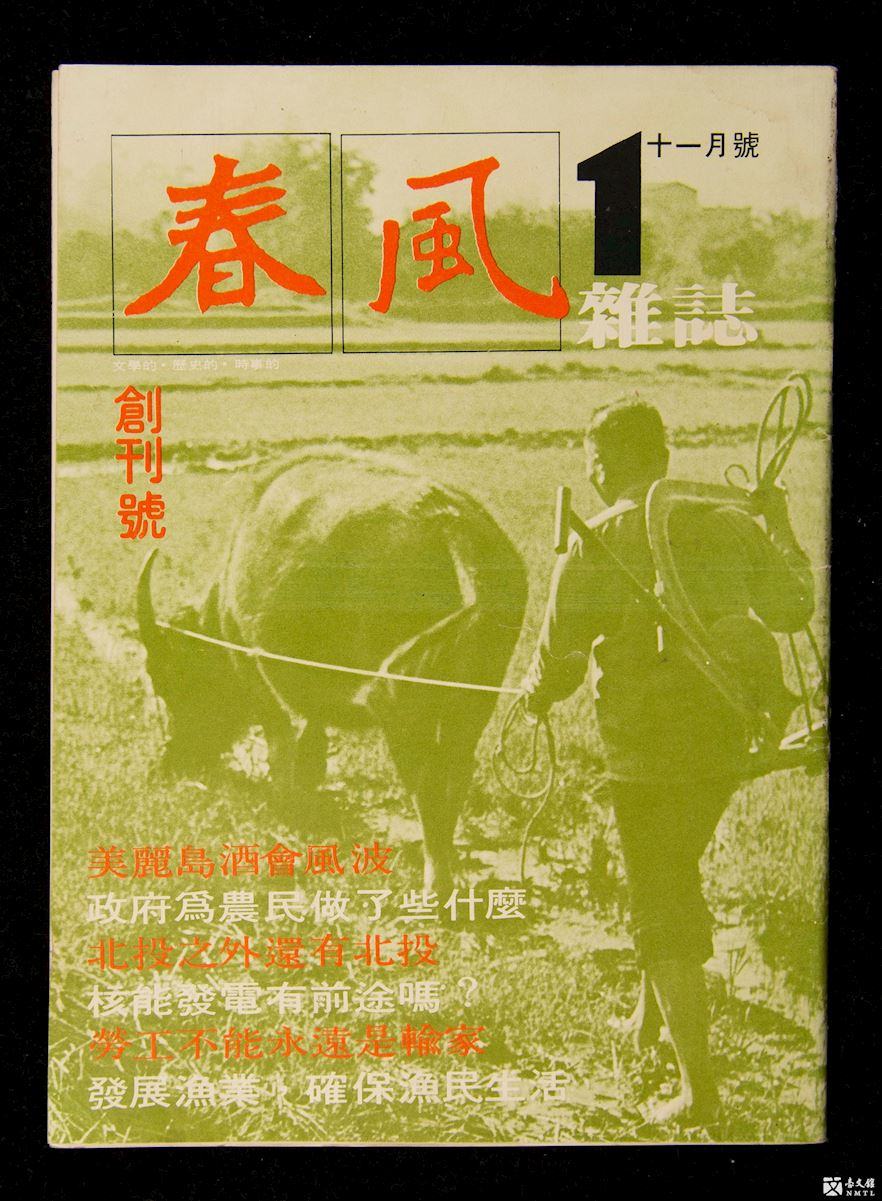
▸ The inaugural issue of Spring Breeze (Donated by Wang Wei-Lian)
Supervised by editor-in-chief Su Yi-Fan (Su Qing-Li), Spring Breeze was first issued in 88 pages in November 1979 and had only one other issue before its publication ceased at the end of that year. Developed as the "outside the party" group and grassroots movements gained political clout in Taiwan, Spring Breeze was founded on November 1, 1979, by publishers Huang Shun-Hsing and Zhan Che (Zhan Chaoli, poet), president Wang Tuoh, and editor-in-chief Su Qing-Li, with an editorial committee comprised of cultural figures such as Wang Jin-Ping, Li Ri-Zhang, Chen Ying-Zhen, Yang Kui, and Jiang Xun. With a foreword beginning with “Spring: the peak season of all life. Spring breeze brings the message of spring! ” the journal’s first issue expressed the purpose of being a voice for workers and farmers from the bottom of society by taking a public stand. The cover articles of the issue reflected the journal’s core values of orientation and care, such as “What Has the Government Done for Farmers?” “What About the Future of Nuclear Power?” and “Laborers Cannot Always Be Losers.” In addition to the foreword, the issue established several columns, including “Our Society,” “To Know the World,” “History,” “Introduction to Books,” and “Literature,” and presented Zhan Che’s poem “Spring Breeze” on its back cover.
The Formosa Magazine incident (i.e., Kaohsiung incident) occurred shortly after the second issue of Spring Breeze was released. During the incident, journal president Wang Tuoh and editor-in-chief Su Qing-Li were arrested, and the journal was suspended. However, as relevant individuals remained devoted to human rights, freedom, and justice, in the early 1980s Zhan Che, Zhong Qiao, and Yang Du founded the Spring Breeze Poetry Society to promote the ideals of Spring Breeze in the future.
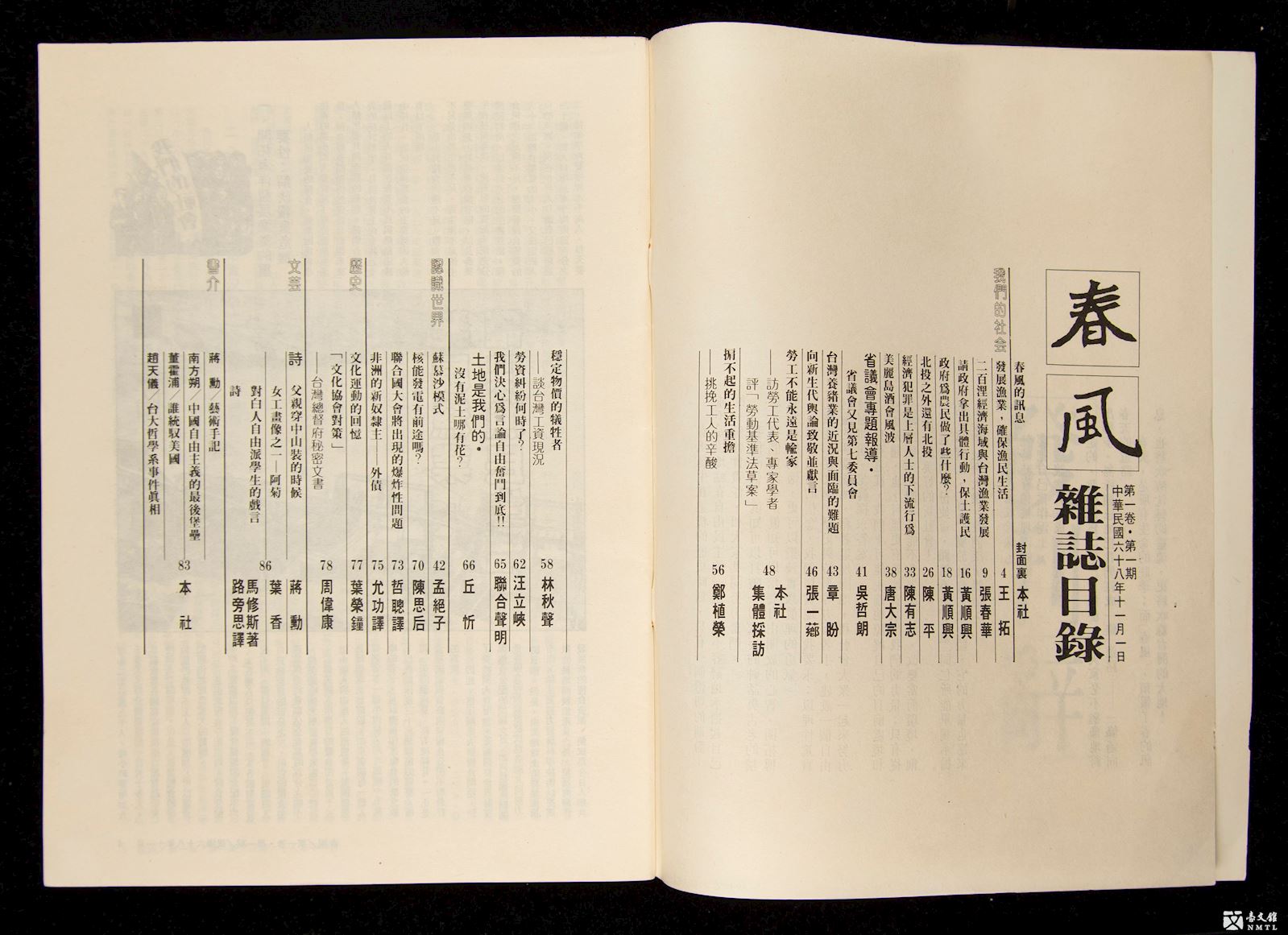
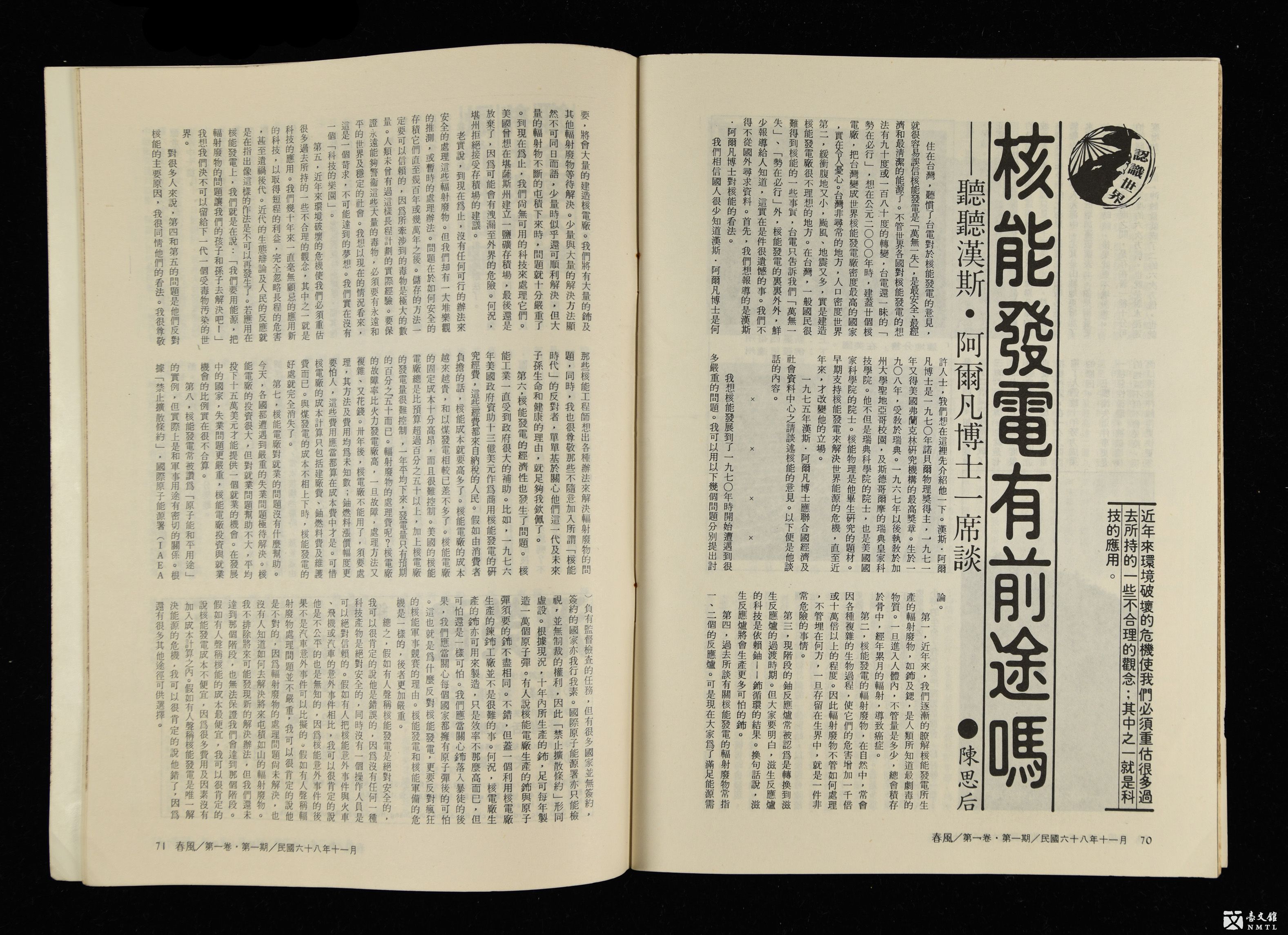
Children's journals
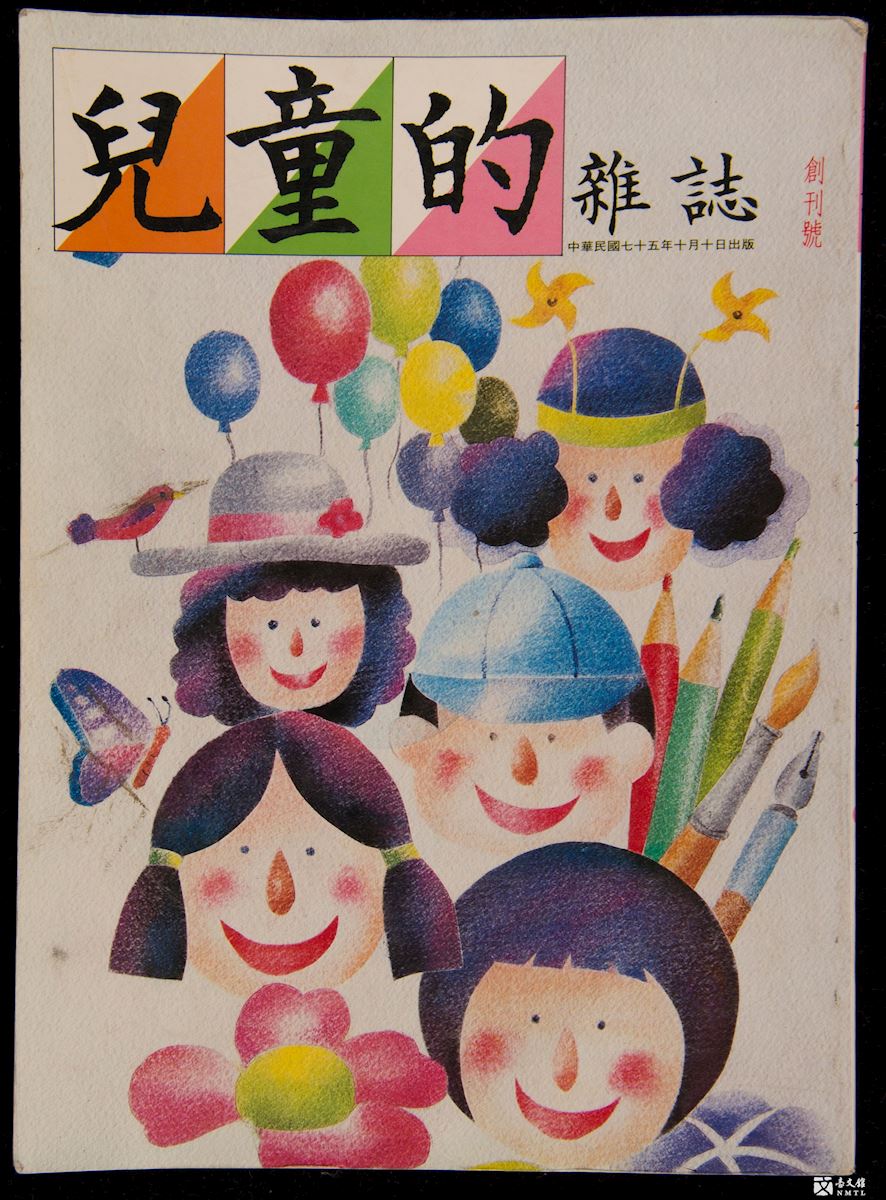
▸ The inaugural issue of Children's Magazine (Donated by Lin Jin-Peng’s family)
The inaugural issue of the Children's Magazine was published by Children's Magazine Press on October 10, 1986, with 104 pages.
He Zheng-Guang served as the editor-in-chief. The magazine was planned by the Children's Reading Compilation Group, which was affiliated with the Education Department of the Taiwan Provincial Government. It was a comprehensive reading book designed for children in primary school. The cover of the inaugural issue was designed by the famous illustrator of children's books, Zhao Guo-Zong. The foreword on the first page, written by Lin Qing-Jiang, the director of the Education Department of the Taiwan Provincial Government, demonstrated that the purpose of this journal was to publish a journal with “knowledge, lifestyle, and interest.” Moreover, the journal aimed to develop children’s imagination and fulfill their soul. The journal contained fairy tales, selected vernacular works translated from classical literature, sections on environment and life, writing classroom, comics, pet breeding, puzzle games, magic and other units. It was presented with both various themes and beautiful layouts. It was not only a crucial publication accompanying children at school age, but it also provided a publishing space for many local writers and contributed to the development of nativist literature. Unfortunately, after two or three years of the reorganization of the Taiwan Provincial Government, the Ministry of Education of Taiwan abolished the Children's Reading Compilation Group due to insufficient budget, which led to the suspension of Children's Magazine. As of December 2002, a total of 190 issues were issued.
